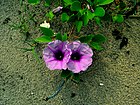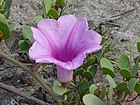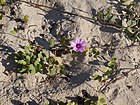Note: This is a project under development. The articles on this wiki are just being initiated and broadly incomplete. You can Help creating new pages.
Difference between revisions of "Ipomoea pes-caprae"
(Created page with "{{stub}} ==Uses== {{Uses|}}, {{Uses|}}, {{Uses|}}, {{Uses|}}, {{Uses|}}, {{Uses|}}, {{Uses|}}, {{Uses|}}, {{Uses|}}, {{Uses|}}, {{Uses|}}.<ref name="Uses"/> ==Parts Used== {{...") |
(→References) |
||
| (4 intermediate revisions by the same user not shown) | |||
| Line 1: | Line 1: | ||
| − | + | [[File:2 in the sea.jpg|thumb|right]] | |
| + | '''Ipomoea pes-caprae''' is a very vigorous, creeping, or scrambling, evergreen, perennial plant with a large, thick root that can be 3 metres long and 5cm in diameter. With stems that can be 30 metres long and root at the nodes, the plant quickly forms a dense mat of low growth, completely covering the soil. | ||
==Uses== | ==Uses== | ||
| − | {{Uses|}}, {{Uses|}}, {{Uses|}}, {{Uses|}}, {{Uses|}}, {{Uses|}}, {{Uses|}}, {{Uses|}}, {{Uses|}}, {{Uses| | + | {{Uses|Dropsy}}, {{Uses|Urethral discharge}}, {{Uses|Ulcers}}, {{Uses|Rheumatism}}, {{Uses|Chicken pox}}, {{Uses|Skin ailments}}, {{Uses|Carbuncles}}, {{Uses|Swellings}}, {{Uses|Ulcers}}, {{Uses|Piles}}.<ref name="Uses"/> |
==Parts Used== | ==Parts Used== | ||
| − | {{Parts Used|}}, {{Parts Used| | + | {{Parts Used|Leaves}}, {{Parts Used|Roots}}. |
==Chemical Composition== | ==Chemical Composition== | ||
| Line 10: | Line 11: | ||
==Common names== | ==Common names== | ||
| − | {{Common names | + | {{Common names|en=Railroad vine, Goat's foot vine|gu=Maryada-vel|hi=Do Patti Lata|kn=ಬಂಗಡ Bangada ಬಂಗಡ ಬಳ್ಳಿ Bangadaballi|ml=Naripadam|mr=Maryada-vel|ta=Attukkal|te=Balabantatige}}<ref name="Common names"/> |
==Properties== | ==Properties== | ||
| Line 16: | Line 17: | ||
===Dravya=== | ===Dravya=== | ||
===Rasa=== | ===Rasa=== | ||
| − | |||
===Guna=== | ===Guna=== | ||
| Line 29: | Line 29: | ||
==Habit== | ==Habit== | ||
| − | {{Habit|}} | + | {{Habit|Evergreen perennial}} |
==Identification== | ==Identification== | ||
| Line 48: | Line 48: | ||
==Mode of Propagation== | ==Mode of Propagation== | ||
| − | {{Propagation|}} | + | {{Propagation|Seeds}} |
==How to plant/cultivate== | ==How to plant/cultivate== | ||
| − | <ref name="How to plant/cultivate"/> | + | Requires a sunny position in a well-drained soil.<ref name="How to plant/cultivate"/> |
==Commonly seen growing in areas== | ==Commonly seen growing in areas== | ||
| − | {{Commonly seen|}}, {{Commonly seen|}}, {{Commonly seen|}}, {{Commonly seen| | + | {{Commonly seen|Sandy dunes}}, {{Commonly seen|Foreshores}}, {{Commonly seen|Roadsides}}, {{Commonly seen|Ditches}}. |
==Photo Gallery== | ==Photo Gallery== | ||
<gallery class="left" caption="" widths="140px" heights="140px"> | <gallery class="left" caption="" widths="140px" heights="140px"> | ||
| + | 2 in the sea.jpg | ||
| + | |||
| + | 2017-01-26 Haemitahama,Iriomotejima,Okinawa 西表島南風見田浜 グンバイヒルガオ DSCF0641.jpg | ||
| + | 555594031 Taijiang National ParkCHIU,CHIH-CHENG 馬鞍藤-爭妍.jpg | ||
| + | Atampu (Tamil- அடம்பு) (3228936526).jpg | ||
| + | Atappan-koti (Tamil- அடப்பங்கொடி) (6679236731).jpg | ||
</gallery> | </gallery> | ||
| Line 64: | Line 70: | ||
<references> | <references> | ||
| − | <ref name="chemical composition">[ | + | <ref name="chemical composition">[Chemistry]</ref> |
| − | <ref name="Leaf">[ | + | <ref name="Leaf">[Morphology]</ref> |
| − | <ref name="How to plant/cultivate">[ | + | <ref name="How to plant/cultivate">[http://tropical.theferns.info/viewtropical.php?id=Ipomoea+pes-caprae Cultivation]</ref> |
<ref name="Uses">Indian Medicinal Plants by C.P.Khare</ref> | <ref name="Uses">Indian Medicinal Plants by C.P.Khare</ref> | ||
| + | |||
| + | <ref name="Common names">[http://www.flowersofindia.net/catalog/slides/Goat%20Foot%20Vine.html Common names]</ref> | ||
</references> | </references> | ||
==External Links== | ==External Links== | ||
| − | * [ ] | + | * [http://www.flowersofindia.net/catalog/slides/Goat%20Foot%20Vine.html Ipomoea pes-caprae on flowersofindia.net] |
| − | * [ ] | + | * [https://indiabiodiversity.org/species/show/263096 Ipomoea pes-caprae on indiabiodiversity.org] |
| − | + | ||
[[Category:Herbs]] | [[Category:Herbs]] | ||
Latest revision as of 12:53, 10 November 2020
Ipomoea pes-caprae is a very vigorous, creeping, or scrambling, evergreen, perennial plant with a large, thick root that can be 3 metres long and 5cm in diameter. With stems that can be 30 metres long and root at the nodes, the plant quickly forms a dense mat of low growth, completely covering the soil.
Contents
- 1 Uses
- 2 Parts Used
- 3 Chemical Composition
- 4 Common names
- 5 Properties
- 6 Habit
- 7 Identification
- 8 List of Ayurvedic medicine in which the herb is used
- 9 Where to get the saplings
- 10 Mode of Propagation
- 11 How to plant/cultivate
- 12 Commonly seen growing in areas
- 13 Photo Gallery
- 14 References
- 15 External Links
Uses
Dropsy, Urethral discharge, Ulcers, Rheumatism, Chicken pox, Skin ailments, Carbuncles, Swellings, Ulcers, Piles.[1]
Parts Used
Chemical Composition
Common names
| Language | Common name |
|---|---|
| Kannada | ಬಂಗಡ Bangada ಬಂಗಡ ಬಳ್ಳಿ Bangadaballi |
| Hindi | Do Patti Lata |
| Malayalam | Naripadam |
| Tamil | Attukkal |
| Telugu | Balabantatige |
| Marathi | Maryada-vel |
| Gujarathi | Maryada-vel |
| Punjabi | NA |
| Kashmiri | NA |
| Sanskrit | NA |
| English | Railroad vine, Goat's foot vine |
Properties
Reference: Dravya - Substance, Rasa - Taste, Guna - Qualities, Veerya - Potency, Vipaka - Post-digesion effect, Karma - Pharmacological activity, Prabhava - Therepeutics.
Dravya
Rasa
Guna
Veerya
Vipaka
Karma
Prabhava
Habit
Identification
Leaf
| Kind | Shape | Feature |
|---|---|---|
Flower
| Type | Size | Color and composition | Stamen | More information |
|---|---|---|---|---|
| {{{5}}} |
Fruit
| Type | Size | Mass | Appearance | Seeds | More information |
|---|---|---|---|---|---|
Other features
List of Ayurvedic medicine in which the herb is used
Where to get the saplings
Mode of Propagation
How to plant/cultivate
Requires a sunny position in a well-drained soil.[5]
Commonly seen growing in areas
Sandy dunes, Foreshores, Roadsides, Ditches.
Photo Gallery
References
- ↑ Indian Medicinal Plants by C.P.Khare
- ↑ [Chemistry]
- ↑ Common names
- ↑ [Morphology]
- ↑ Cultivation
External Links
- Ayurvedic Herbs known to be helpful to treat Dropsy
- Ayurvedic Herbs known to be helpful to treat Urethral discharge
- Ayurvedic Herbs known to be helpful to treat Ulcers
- Ayurvedic Herbs known to be helpful to treat Rheumatism
- Ayurvedic Herbs known to be helpful to treat Chicken pox
- Ayurvedic Herbs known to be helpful to treat Skin ailments
- Ayurvedic Herbs known to be helpful to treat Carbuncles
- Ayurvedic Herbs known to be helpful to treat Swellings
- Ayurvedic Herbs known to be helpful to treat Piles
- Herbs with Leaves used in medicine
- Herbs with Roots used in medicine
- Herbs with common name in Kannada
- Herbs with common name in Hindi
- Herbs with common name in Malayalam
- Herbs with common name in Tamil
- Herbs with common name in Telugu
- Herbs with common name in Marathi
- Herbs with common name in Gujarathi
- Herbs with common name in English
- Habit - Evergreen perennial
- Index of Plants which can be propagated by Seeds
- Herbs that are commonly seen in the region of Sandy dunes
- Herbs that are commonly seen in the region of Foreshores
- Herbs that are commonly seen in the region of Roadsides
- Herbs that are commonly seen in the region of Ditches
- Herbs





